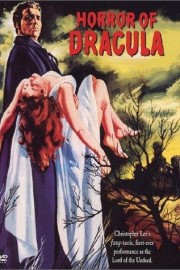Horror of Dracula
The best adaptation of Bram Stoker’s Dracula remains, perhaps for all-time, F.W. Murnau’s “Nosferatu,” but Terence Fisher’s 1958 film of the story for Hammer Films, “Horror of Dracula,” is perhaps my favorite. It follows the most basic elements of the story, but adds a level of elegant theatricality in performance and look that distinguishes it from the other great movies of this story. Francis Ford Coppola tried the same thing with his 1992 version of the film, but that film failed dramatically for me, regardless of how great it was to look at.
Fisher’s film begins as most “Dracula” films do, with Jonathan Harker heading to Transylvania to meet Count Dracula (played here by Christopher Lee). Unlike other Harkers, however, this one knows full well what Dracula is, and looks not to sell him property, but to bury him in his own damned soil. Unfortunately, he is unable to do so, and dies at the hands of Dracula and his evil bride. Not long after, Professor Van Helsing (Peter Cushing) makes his own way to Dracula’s castle, only to find his friend’s vampire body left for him. Van Helsing shortly returns to London to tell the family of Harker’s fiancee, Lucy (Melissa Stribling), and finds that Dracula has made his way to London when Lucy is bed-ridden with what appears to be anemia. After her death, it is up to the good Professor and Lucy’s brother (played by Michael Gough) to try and put a stop to the terror.
Part of what makes “Horror of Dracula” so exciting are the changes Fisher and screenwriter Jimmy Sangster made to the story: namely, making Harker aware of Dracula’s true nature, and shifting the focus to Van Helsing. Dracula, in the end, is not as compelling a character, especially after the “definitive” performance by Bela Lugosi in Tod Browning’s 1931 classic, although Lee more that equates himself in the role. Van Helsing, on the other hand, is fascinating. What drives his fascination with vampirism? What led him on the hunt to begin with? I’m sure Hammer’s endless sequels delved further into those questions, but Cushing’s riveting performance in this movie sets the stage.
Color adds a great deal to the film. Unlike the haunted black and white of the earlier versions by Murnau and Browning, Fisher’s film uses color to add theatricality and, in a way, menace to the film; the red of dripping blood on a vampire’s fangs is always a horrifying sight in any vampire movie. That said, it comes down to the ever-powerful story of good vs. evil at the center of the film, and the way Fisher and the imaginative people of Hammer saw bringing it to life, that makes “Horror of Dracula” live on in audience’s memories.










